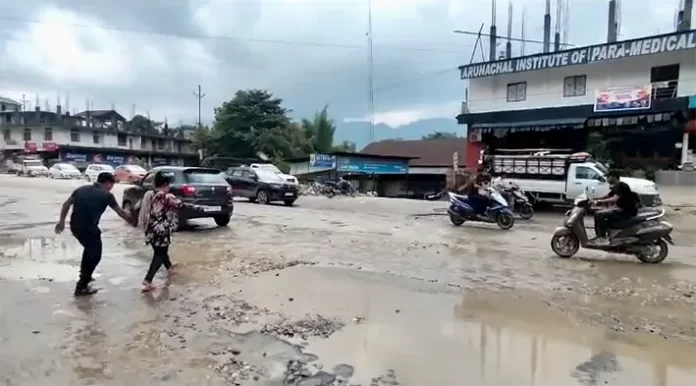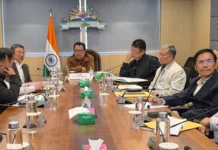[ Harshwardhan Pillai ]
Despite its status as the capital of Arunachal Pradesh and its ongoing development under the Smart Cities Mission, Itanagar remains critically unprepared to handle the challenges posed by heavy monsoon rainfall.
Days of relentless rain have once again crippled the city’s infrastructure, leaving behind broken roads, overflowing drains, mud-clogged streets, and deep potholes. The damage has severely disrupted daily life, affecting office-goers, two-wheeler riders, Tempo drivers, and local residents who rely on these public roads for their everyday commute.
The road leading from Papu Nallah to Nirjuli comes under Package B of National Highway 415. Currently the road from the Barapani bridge has been diverted via Yupia road, so as to build the piers for the flyover in Naharlagun, informed a PWD official. Altogether 146 piers are to be developed for the flyover, which is expected to be completed by 2026, after being extended twice since the stipulated deadline.
This year, TK Engineering (TKE) was removed from the sub-contractor work under M/s Woodhill Shivam, a construction company based in Bhubaneshwar (Odisha). The executing agency is the Public Works Department (PWD).
M/s SPS Technocrate Private Limited has replaced TKE over the latter’s slow pace of work as sub-contractor.
Woodhill Shivam had been allotted 51 percent of the work, and TKE was to complete the remaining 49 percent. TKE has completed about 8-9 percent of the work, said an official from the PWD.
The deadline for completion of the work under the Package B was 8 December last year.
While the rain has now subsided, the consequences continue to impact thousands across the capital and nearby localities. This is not the first time that Itanagar and its nearby connected areas, such as PapuNallah, Naharlagun, Lekhi and Nirjuli have faced such devastation due to weather. Despite being surrounded by hills and natural water bodies, which should ideally support effective drainage solutions, the city’s infrastructure remains poorly equipped to handle even moderate rainfall. Questions are now being raised by citizens and observers alike – why does a developing smart city still lack a functioning drainage system? Why has the natural topography not been effectively utilized to divert rainwater and prevent annual flooding?
Adding to the public frustration is the worsening situation in areas surrounding the capital. Many residents argue that while Itanagar itself is under development, nearby towns and villages remain largely neglected. These regions, equally prone to water-induced damage during the monsoon, often receive little to no immediate support from government agencies.
Roads in these areas are frequently washed away, drains are either non-existent or blocked, and landslides are a recurring threat. Locals feel there is no consistent governmental reach or infrastructure plan in place to protect these communities.
Illegal earth-cutting and unregulated construction have further aggravated the problem. Soil erosion from such activities has clogged drains with debris, blocking the natural flow of water and causing it to overflow onto city roads. Reports of corruption, substandard building materials, and a lack of accountability from contractors and departments involved in infrastructure work have also been voiced.
Recent flood incidents across Arunachal Pradesh, and accompanying landslides that have claimed 11 lives so far across the state , have reinforced the urgent need for better planning. (The writer is a student of St Claret College, Ziro, and is currently interning with The Arunachal Times)




